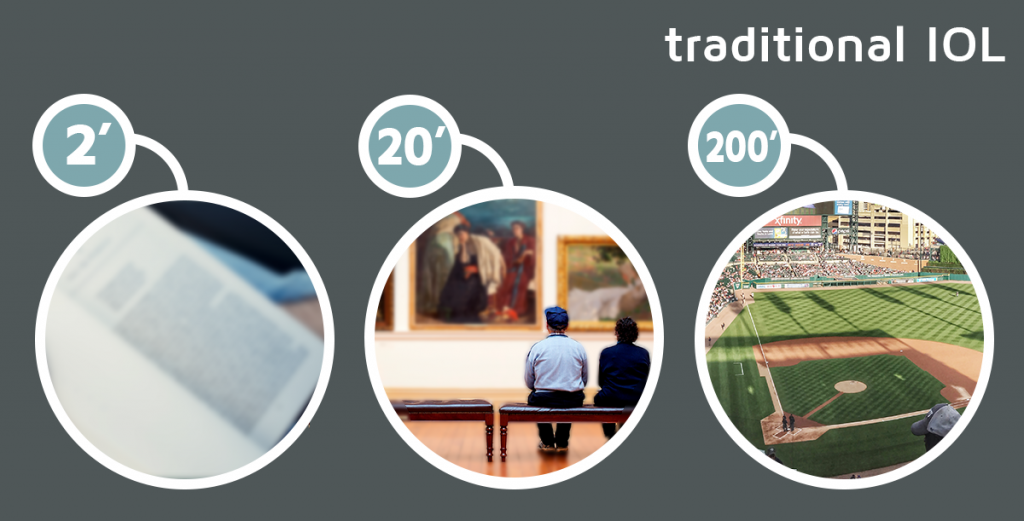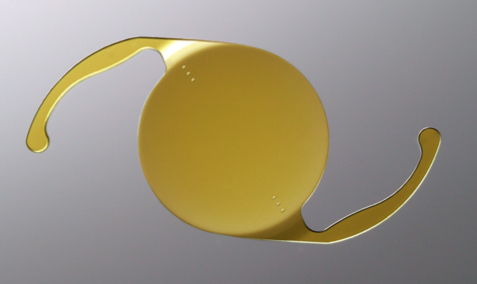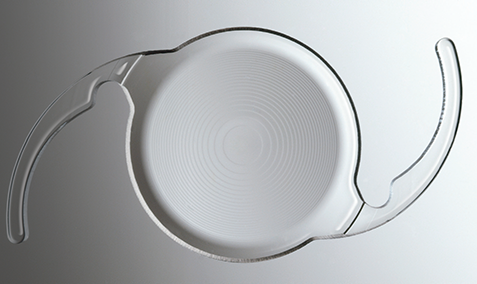One of the most important developments in the history of cataract surgery, as well as one of the most significant for patients, was the introduction of the intraocular lens implant, or IOL. First invented in the 1940s, but gaining widespread acceptance only since the late 1970s, an IOL is an artificial lens placed into the eye after the natural human lens is removed in a cataract or other lens extraction surgery. By replacing the lost refractive power of the natural lens, IOLs revolutionized cataract surgery. No longer were cataract patients dependent on thick, heavy, and uncomfortable “cataract glasses” for the rest of their lives, and one of the most pervasive complaints about cataract surgery was made far less inconvenient.
However groundbreaking the lens implants of the 1970s, 80s, and 90s were, they were not without their limitations. The IOLs of the day, which would be called “traditional” or “conventional” IOLs today, were spherical, monofocal lenses. The best-case outcome for a cataract patient receiving those IOLs was good distance vision with little or no need for glasses – if the patient was fortunate enough to have little or no astigmatism. Patients with significant astigmatism, which the spherical lens could not correct, would need glasses or contact lenses for driving and other tasks requiring good long-range vision.
That was not the only drawback of the traditional IOL. The human eye depends on the flexibility and pliability of the natural lens in order to focus on near objects, a function known as accommodation. That ability is lost when the natural lens is replaced with an artificial lens implant made of stiff polymer. This meant that with or without astigmatism, cataract patients receiving conventional IOLs needed reading glasses or bifocals in order to read, sew, and perform other close work.
In the decades after IOLs gained broad acceptance, lens manufacturers continued working on improvements in the lens implants, with the help of many consulting physicians. While many of those developments in lens implant technology represented small incremental improvements in function, the late 1990s brought new, groundbreaking lenses that addressed the major issues with the traditional IOL. These new lenses can be roughly divided into two main categories: toric IOLs, which addressed the problem of astigmatism; and multifocal and accommodating IOLs, which addressed the problem of near vision after removal of the natural lens. (These two categories are on the point of merging, as toric/accommodating and toric/multifocal IOLs are now being developed.) Collectively, they are often referred to as premium IOLs, and they are arguably the most important advances in cataract surgery since the advent of the intraocular lens implant.
Toric IOLs were first introduced in 1994, but did not gain final FDA approval until 2005. In the same way as a toric contact or eyeglass lens, a toric IOL features zones of additional refractive power along one axis of the surface. This means that, when placed by a skilled surgeon, a toric IOL can correct astigmatism at the same time that it corrects near- or farsightedness. The result is excellent vision in the distance, even for patients with significant astigmatism who would otherwise have been dependent on glasses for distance vision (and bifocals for near vision).
Accommodating IOLs seek to improve near vision by mimicking the accommodative ability of the human lens. An accommodating IOL is made of a flexible material, and placed so that the muscle responsible for accommodation (known as the ciliary muscle) can cause the lens to flex. The first accommodating IOL received FDA approval in 2003 under the trade name Crystalens, and has undergone several revisions and refinements since then.
Multifocal IOLs approach the issue of near vision differently. Similarly to a bifocal eyeglass lens, a multifocal IOL features zones of increased refractive power radiating from the center of the IOL. For patients who are good candidates for multifocal IOLs, these zones can provide good vision at short, medium, and long range, often with little to no need for glasses. Since the FDA approval of the first multifocal IOL, the AMO Array, numerous new multifocal IOLs have been developed, continually improving on the effectiveness of these lenses.
As premium IOLs have become more and more refined, the procedure known as refractive lens exchange (or RLE; sometimes called clear lens exchange or CLE) has become increasingly popular. RLE is identical to cataract surgery except that it is performed before a clinically significant cataract has formed. It can be an excellent option for patients age 45-60 who want improved distance as well as near vision, and offers outstanding results, especially with the advanced multifocal IOLs such as the Tecnis MF Low Add.

With modern multifocal IOLs, patients can achieve excellent vision at near, middle, and long range, while reducing or eliminating the need for corrective eyewear after surgery.
The cataract and lens specialists at Whitsett Vision Group are on the leading edge of this exciting and rapidly advancing field, being both a high-volume lens surgery practice and an in-demand clinical trial site for new IOLs. Unique among surgery practices, Whitsett Vision Group was a clinical trial participant for two of the most widely-used and highly-regarded multifocal IOLs: the AMO ReStor and the Tecnis MF Low Add. (In fact, Dr. Jeffrey Whitsett performed the first Tecnis Low Add procedure in the United States after final FDA approval.) Early looks at new technologies like these ensure that our surgeons have the advantage of experience in their use, and can determine which patients are most likely to experience good results with a premium as opposed to a conventional lens.
If you have any questions about premium IOLs, or are interested in finding out whether you may be a good candidate for RLE or cataract surgery with one of these high-tech lens implants, please do not hesitate to contact us. It would be our pleasure to make an appointment for you with one of our doctors, who will examine your eyes and explain your vision correction options to you, as well as answering any questions you may have.




